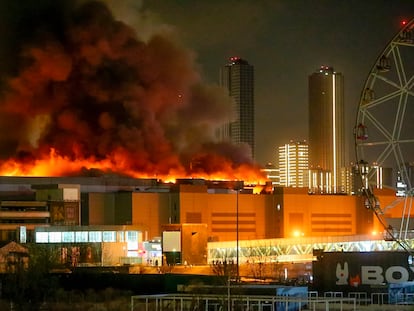The capital of terror
Putin’s Russia is a factory of conspiracy theories that does not shy away from inventing a link between the Islamic State and Ukraine, or even NATO and Washington if it feels the need to do so
Terrorism is an old acquaintance in Lubyanka, the headquarters of the defunct Soviet KGB, now the FSB, Russia’s security services. It was there that Vladimir Putin learned everything that allowed him to reach the top almost 25 years ago and prepared him to remain there until at least 2030, as has been confirmed in the recent election. The great art of blackmail, the kompromat (damaging information) and self-incrimination, poison, bombs and guns, torture, gulags and solitary confinement are the specialty of the house, and have been practiced in massive, inhuman doses, in the name of Soviet socialism until 1993 and of Holy Russia since then.
Terror at the service of the state has a very long history, all the way to the tsars, then Lenin and especially Stalin, one of the biggest mass murderers in history, whom Putin has begun to rehabilitate. The practice was only interrupted by a brief pause between Gorbachev and Yeltsin’s first term, when the country’s elite decided to abandon the violent Soviet tradition. That ephemeral discontinuity at the top had no reflection in the police foundations of power, to the point that it was the siloviki (the strong men in Russian) who kept alive the flame; they controlled the state from the basements and then placed one of their own directly on the tsar’s throne.
Putin’s ascension at the end of 1999 occurred in the middle of a wave of massive attacks in which more than 300 people died, similar to the one perpetrated this past Friday at the Crocus City Hall in Moscow. Those attacks were attributed to Chechen terrorists, and served to justify the brutality of the Russian intervention in the second Chechen war. Catherine Belton, a former Financial Times correspondent in Moscow and Putin biographer, has wondered in her book Putin’s People: How the KGB Took Back Russia and Then Took On the West, whether security operatives could have been the ones who bombed their own people in an attempt to create a crisis that would ensure Putin’s presidency.
It is not an insidious question, since very little has emerged about the authorship of that terrorist campaign of September 1999, to the extent that those who investigated it died in strange circumstances or were imprisoned, as has happened so many times before with numerous murders of journalists, businesspeople, former secret agents and dissidents. The inexplicable and unexplained death of Alexei Navalny on the eve of the elections is the last and politically relevant of all these cases. If those attacks led Putin in the direction of power, in Moscow today, on the contrary, his inability to protect the population and his weakness as a ruler are evident, just when he had been re-elected.
Nothing has gone off-script in the Kremlin’s pattern of behavior. The first reaction from Putin’s entourage has been to point directly at Kyiv. In his speech regarding the attacks, the Russian president had not one word about the Islamic State even though the latter has claimed responsibility for the massacre; instead he suggested the complicity of Ukraine and mentioned Nazism, the same nefarious label with which he attacks Kyiv and its allies. This Putinist Russia is a factory of conspiracy theories, following a tradition that also comes from tsarist times. Putin was not going to quit now and fail to present a link between the Islamic State and the democratic regime in Kyiv, or even with NATO and Washington if necessary, in order to intensify the bombing of Ukraine as revenge.
Sign up for our weekly newsletter to get more English-language news coverage from EL PAÍS USA Edition
Tu suscripción se está usando en otro dispositivo
¿Quieres añadir otro usuario a tu suscripción?
Si continúas leyendo en este dispositivo, no se podrá leer en el otro.
FlechaTu suscripción se está usando en otro dispositivo y solo puedes acceder a EL PAÍS desde un dispositivo a la vez.
Si quieres compartir tu cuenta, cambia tu suscripción a la modalidad Premium, así podrás añadir otro usuario. Cada uno accederá con su propia cuenta de email, lo que os permitirá personalizar vuestra experiencia en EL PAÍS.
¿Tienes una suscripción de empresa? Accede aquí para contratar más cuentas.
En el caso de no saber quién está usando tu cuenta, te recomendamos cambiar tu contraseña aquí.
Si decides continuar compartiendo tu cuenta, este mensaje se mostrará en tu dispositivo y en el de la otra persona que está usando tu cuenta de forma indefinida, afectando a tu experiencia de lectura. Puedes consultar aquí los términos y condiciones de la suscripción digital.
More information
Archived In
Últimas noticias
Most viewed
- Alain Aspect, Nobel laureate in physics: ‘Einstein was so smart that he would have had to recognize quantum entanglement’
- Alvin Hellerstein, a 92-year-old judge appointed by Bill Clinton, to preside over Maduro’s trial in New York
- Gilles Lipovetsky: ‘If you want to live better and fall in love, take Prozac, don’t look to philosophy’
- Cuba confirms death of 32 of its citizens in the US attack against Venezuela
- Why oil has been at the center of Venezuela-US conflicts for decades











































